I was very happy this Christmas to get a
copy of a book containing the early history of the town of
Monterey. The book titled “Standing Stone, Tenn. Monterey Early
History,” was written by the late John Roy Dillard. I immediately
learned three things from this book that I was totally unaware of.
The first is the fact that Monterey was originally called Standing
Stone, TN. The second is that not long after the establishment of
the town, it became known for its resort hotels. The third and
most surprising was that some of my ancestors were connected with
one of the hotels. Permission was graciously given to me to use
information from the book, and the following is a look back at the
hotels that once had a very thriving business in the small town once
known as Standing Stone, TN.
Tourists both the east and west were
brought into the town of Standing Stone by excursion trains, and as
a result, the hotels did a booming business. Those in operation
first were the West Crest, the Southern, the Park, and the Ramsey,
later known as the Commercial. The magnificent three-story
Cumberland Hotel was completed in 1902, while work on the
three-story Dow Hotel was begun that same year.
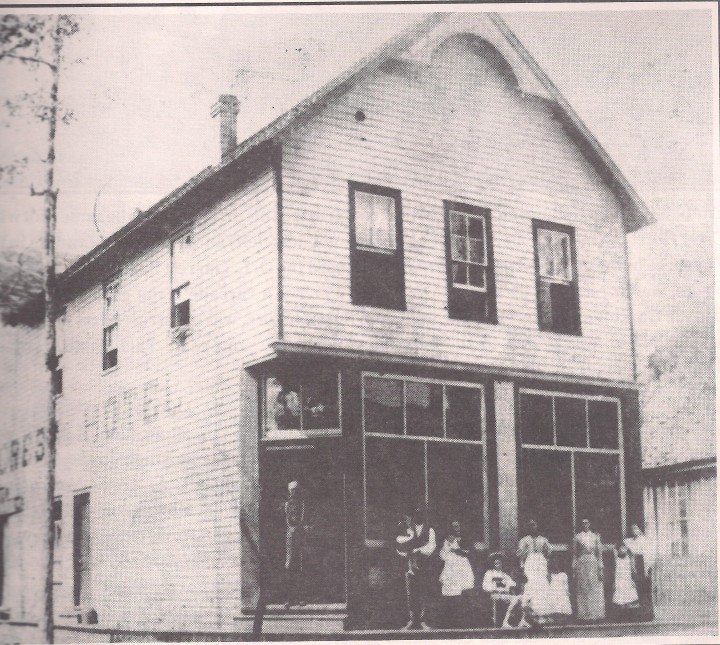
The West Crest Hotel, completed in
the spring of 1894, once stood in Standing Stone, TN, now known as
Monterey.
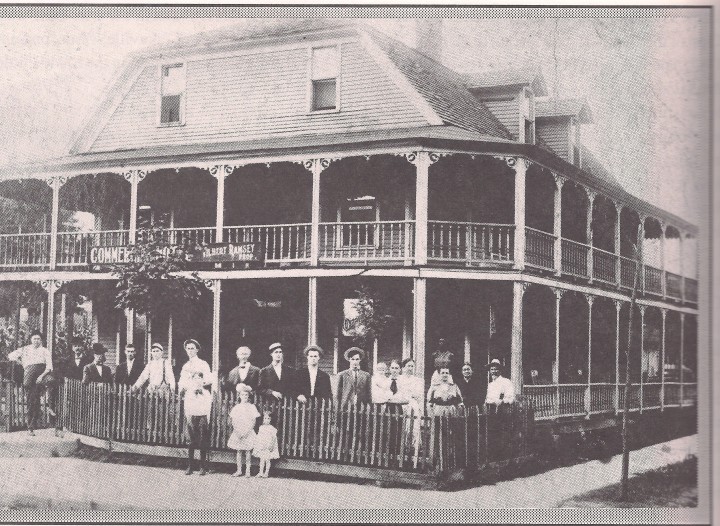
The Commercial Hotel was one of the many fine resorts once located in Monterey, TN.
The West Crest Hotel was completed in
the spring of 1894. Arthur Ashley was the owner at that time, and
later, as a result of Mr. Ashley’s financial difficulties, the hotel
was sold at auction in 1896. It was bought by Thomas Emmett Goff
who was a resident of Livingston at the time he purchased the
business. Prior to his marriage, Thomas Emmett Goff and his father
were in business together traveling about the country selling Seth
Thomas clocks that sold between $8.00 each to a deluxe model for
$15.00. Some additional interesting information about Mr. Goff is
that his wife, Edna Reed Goff, was the only child of Dr. Daniel Reed
and wife Matilda Reed, the owners of the popular Reed House in
Livingston. The Goffs were married at the Reed House on March 24,
1887, and to their union, five children were born whose names were
Willie; Dock; Maudie; Dewey; and Jess. The three older children
were born at the Reed House. Thomas Emmett Goff eventually took
over the running of the Reed House, and spent eight years in charge
of that establishment. It was his experience with the Reed House
that helped get the West Crest Hotel up and running again once he
took over the ownership. It wasn’t until 1903 that the completion
of a 20-room addition to the West Crest was made. This hotel,
along with three other buildings, was destroyed by fire in 1905.
Two additional hotels, The Monterey Hotel and The Imperial Hotel,
were built later with the railroader in mind, and therefore were not
considered resort hotels. When the Tennessee Central Railroad was
completed from Monterey to Emory Gap on September 18, 1900, the town
of Monterey became one of the leading summer resorts in all of
Tennessee.
In the summer of 1898, the Monterey
Hotel Company was organized and soon thereafter, constructed a
handsome resort hotel first known as the Reagan Hotel. It was
completed on March 1, 1899 and displayed modern architecture. It
was built to give comfort and pleasure to its guests. The land
surrounding it was well manicured and lots of shade trees. Mr.
William Reagan, an old hotel hand with wide experience, leased the
hotel from the Monterey Hotel Co. The Reagan Hotel stood on the
southeast corner of Cleveland Avenue and Oak Street. It was an
imposing two-story wooden structure with a porch and balcony
extending the entire length of the building in front. There were
twenty sleeping rooms, an office, parlor, dining room and culinary
department all on the first floor. Some extensive improvements were
made to the building in 1901 with the addition of a 40X60 foot
dining room, a new parlor, and sixteen new sleeping rooms. Elegant
furniture was purchased and everything was in readiness for a new
opening date. The hotel took on the shape of an “L” when the new
addition was completed. The opening of the remodeled hotel was held
on June 10, 1901, and was quite a special event. An all-day program
included a musical in the afternoon and a ball in the evening. The
Reagan Hotel continued to be a bee hive of activity as trains
stopped at the Oak Street crossing to discharge passengers for the
short walk to the hotel. Shortly after the 110-room Cumberland
Hotel was completed in 1902, the Monterey Hotel Co., who owned both
the Cumberland and the Reagan Hotels, converted the Reagan into a
family dwelling place and placed Captain J. Orill in charge. From
then on the Reagan Hotel was known as the Park Hotel.
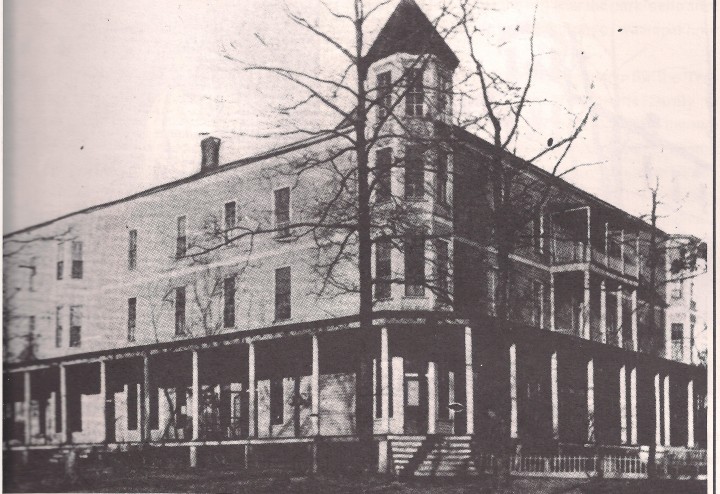
The Cumberland Hotel in Monterey
boasted 110 rooms.
The Cumberland Hotel, originally known
as the Ramsey Hotel, was built by Tilbert Ramsey in the early
1900's. He came to Monterey from Overton County. The hotel
contained about 30 sleeping rooms and was completely surrounded by
an upper and lower veranda. There was a long table in the dining
room and meals were served home-style. One of the Ramsey
granddaughters used to go through the hallways ringing the dinner
bell, calling the guests to come and eat. The hotel had two black
cooks who did most of the cooking. They lived upstairs over the
storehouse and entered their sleeping quarters from an outside
stairway at the rear of the hotel. The name was eventually changed
to the Cumberland Hotel, and a grand opening was held on June 1,
1902 under the management of Mr. and Mrs. Jessie F. Miller. Under
their supervision, the Cumberland Hotel became one of the most
famous resort hotels in the state. It was preferred by most
tourists because of Monterey Park and its recreational advantages.
It was built on a beautiful 105 acre tract of land that made up the
park complex and contained a swimming pool and two bowling alleys.
There was manicured lawns with beautiful flowers, tennis courts,
along with summer cottages that dotted the nearby landscape. The
water supply came from the nearby mineral springs. A huge water
tank that held several thousand gallons of the purest freestone
water sat at the back of the hotel. Two brick pump houses built
just under the hill near the entrance to the park could supply up to
600 gallons of water per hour if needed. The Commercial Hotel was
described by a Knoxville newspaper reporter in 1910 as one of the
most beautiful buildings in Monterey.
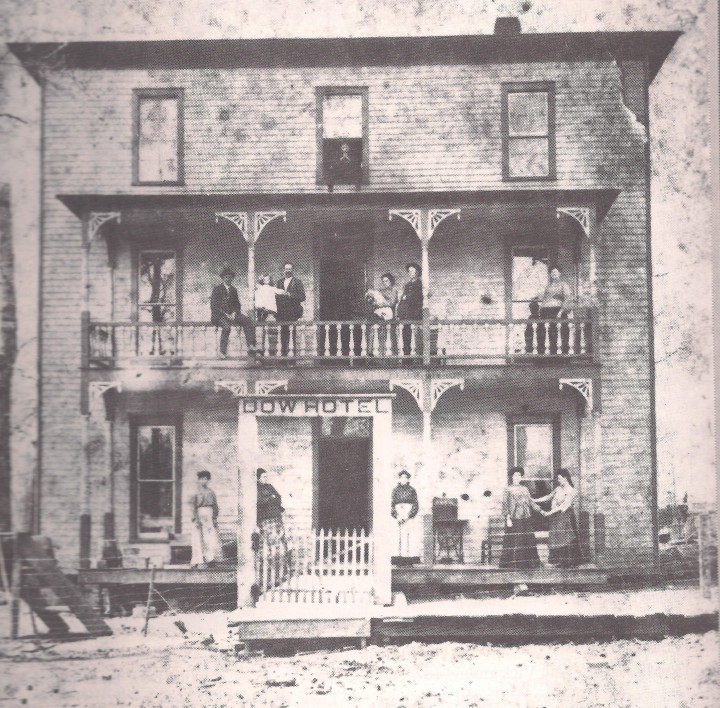
The Dow Hotel later became known as the Holloway Hotel in Monterey.
The Dow Hotel was built by L. Jerdon Dow
in 1902. Mr. Dow offered an entire floor of his hotel to
out-of-town students who were attending Monterey High School at a
reduced rate of $9.00 per month. Jerdon Dow operated this hotel
for a little over two years and then leased the boarding department
to Rollie W. King in 1905. Mrs. Ann Dow, wife of Jerdon Dow, sold
the hotel to Lloyd Chapin (this name should be William Paul Chapin)
soon after her husband died in 1907, and his widow, Sibba Chapin,
sold the three-story hotel to John Holloway in the summer of 1914.
The Chapins and the Holloways were related. John Holloway moved his
family into the Dow Hotel soon after it was purchased, and from then
on, it was known as the Holloway Hotel. Before coming to Monterey
in the late 1890s, John Holloway operated a small country store at
Mineral Springs. His first business venture in the town of Monterey
was a partnership with his brother, Thomas Bailey Holloway. They
constructed a wood-frame store building and went into the general
merchandising business. The two brothers also bought and sold real
estate. John Holloway was married to Lee Andrews and they raised
five children. At the time of Mr. Holloway’s death on December 1,
1943, he had been engaged in the mercantile business in Monterey for
40 years. He also served for a number of years on the Putnam County
Board of Education.
Monterey’s colorful resort ear reached
its peak around 1905, and business continued to be good for the next
eight to 10 years. Tourists who came in by train were let off at
the Oak Street crossing, sometimes called the Caraway Switch
Crossing, which was close to the Cumberland and Park Hotels.
However, with the coming of the automobile, times changed, and so
did the vacation habits of tourists. Good roads were being built,
meaning people no longer had to depend on the railroad for
transportation. Tourists who once rode the rails were now buying
cars and driving to new places and seeing new sights. By 1914,
tourist business in Monterey had dwindled to the point that the
Cumberland Hotel operated with three-fourths of its 110 rooms
empty. The hotel was eventually sold to The Episcopal Church in
1914, and two years later, the magnificent structure was destroyed
by fire, claiming the life of one student. The location of the
once thriving hotel eventually became a service station.
T
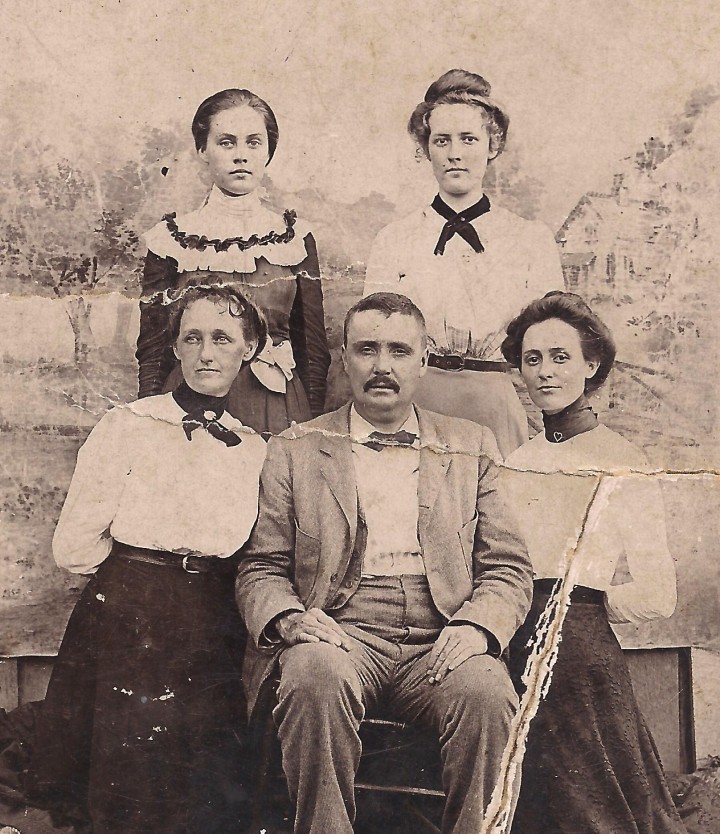
Five of the grandchildren of William
Paul Chapin and wife Amanda Swift Chapin were photographed together.
Top row: Matt Draper Keisling;
Allie Draper McCormick;
Front row: Willie Chapin Myers
Cannon (grandmother of Patricia Smith Lander of Atlanta and Peggy
Smith Pangle of Livingston); Tom Holloway; Ninnie Draper McCormick
(my grandmother).
The Chapin family and the Holloway
family mentioned as having once owned the Dow Hotel are connected to
my family tree through my grandmother Ninnie Draper McCormick’s side
of my family. Although the information in the Monterey book says
that the Dow Hotel was once owned by Lloyd Chapin, the correct name
should be William Paul Chapin whose second wife was Sibba
Daugherty. Lloyd Chapin and William Paul Chapin were brothers, so
it’s possible their names could have been confused. John and Tom
Holloway’s mother, Sarah Rebecca Chapin Holloway, wife of Sam
Holloway, was a sister to William Paul Chapin and Lloyd Chapin.
When Sarah Rebecca Chapin Holloway died from T.B., her young
children were raised by family members. Her son, Tom Holloway,
lived with William Paul Chapin and his first wife, Amanda Swift
Chapin. William Paul Chapin was my great-great grandfather, as well
as the great-great grandfather of Peggy Smith Pangle of Livingston,
and her sister, Patricia Smith Lander of Atlanta.
The gift of the book on the early
history of Monterey has been two-fold for me. In additional to
other historical and interesting information, had I not received
that book, I would certainly never have known how my ancestors were
once owners of a fine resort operated long ago in the neighboring
town once known as Standing Stone, TN.